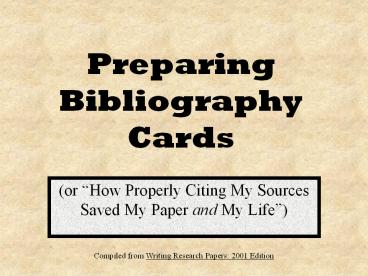Preparing Bibliography Cards PowerPoint PPT Presentation
Title: Preparing Bibliography Cards
1
Preparing Bibliography Cards
- (or How Properly Citing My Sources Saved My
Paper and My Life)
Compiled from Writing Research Papers 2001
Edition
2
Bibliography Cards - Whats the Point?
- Bibliography cards serve three purposes
- Well written bibliography cards allow you to find
your source information quickly. - They allow you to prepare documentation for your
paper. - Bibliography cards also allow you to prepare the
Works Cited list that appears at the end of your
paper.
3
Bibliography Cards (cont.)
- Documentation is material included in a research
paper to identify the sources from which
information was taken. - The Works Cited list is a complete record of the
sources referred to in the paper.
4
How to Create a Bibliography Card
- A bibliographic entry gives essential information
about a source, such as its author, title, place
and/or date of publication, and the pages (if
applicable) on which it was found. The first line
begins in the upper left-hand corner of the card.
Subsequent lines are indented a few spaces.
Steinbecks Literary Dimension A Guide to
Comparative Studies. Metuchen Scarecrow, 1973.
Hayashi, Tetsumaro.
5
How to Create a Bibliography Card
- A source note tells where you found the source.
The source listed on the card below was found at
the Lucius Beebe Memorial Library. The source
note will help you find the source again if you
need to do so.
Hayashi, Tetsumaro. Steinbecks Literary
Dimension A Guide to Comparative Studies.
Metuchen Scarecrow, 1973.
Lucius Beebe Memorial Library
6
How to Create a Bibliography Card
- A source number is written in the upper
right-hand corner of the card and circled. Assign
a unique number to each source you find. You will
use this number to refer to the source on note
cards containing material from that source.
1
Hayashi, Tetsumaro. Steinbecks Literary
Dimension A Guide to Comparative Studies.
Metuchen Scarecrow, 1973.
Lucius Beebe Memorial Library
7
How to Create a Bibliography Card
- A card catalogue number, if appropriate, should
be included. If your source comes from a library
and has a catalogue number, you should write that
number in the lower right-hand corner. The
catalogue number will help you find the source
again if you need to do so.
1
Hayashi, Tetsumaro. Steinbecks Literary
Dimension A Guide to Comparative Studies.
Metuchen Scarecrow, 1973.
Lucius Beebe Memorial Library
813.08
8
Bibliography Card Recap
- Locate information on your sources.
- Make a bibliography card for it, using a 4 x 6
index card. - Find the appropriate bibliography form in Writing
Research Papers, Appendix C on pages 82-91 (or
search MLA Citations or MLA Works Cited
Documentation ). - In the top right-hand corner of the card, record
a source number and circle it.
9
Bibliography Card Recap
- At the bottom of the card, record the place where
you found the source. - If the source has a catalog number, record that
number as well (in the lower right-hand corner). - Stack the card with the rest of the cards that
make up your working bibliography.
10
The End
or is it?
Be sure to tune in next week to Thesis - Or
What the Heck am I Trying to Prove?

